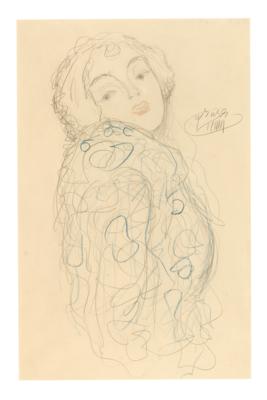Gustav Klimt

(Vienna 1862–1918)
Lady portrait bust to the right, head turned to the front, portrait drawing to the painting “Bildnis Ria Munk III” 1917/18 incomplete - (Novotny-Dobai no. 209, Weidinger no. 246 - there titled Damenbildnis resp. Frauenbildnis, Natter no. 236), signed (oval) Gustav Klimt, pencil, red and blue colour pencil on paper, 50 x 32.5 cm, passep.-cutout 48 x 31 cm, framed
Alice Strobl, Gustav Klimt. Die Zeichnungen 1912–1918, vol. III, Verlag Galerie Welz, 1984, p. 126/2627, p. 127 ill.
Noted under Strobl no. 2627:
Signiert re. oben: “Gustav Klimt” (oval) (von fremder Hand?)
Marian Bisanz-Prakken examined this drawing in original in spring 2022 – the signature is by Gustav Klimt.
Provenance:
Private Collection, Vienna
Autonomous, mostly anonymous female half-portraits can be found in Klimt’s drawings from around 1895 onwards. The artist was not primarily concerned with the individual characteristics of the posing women in these drawings, but with the subtle exploration of diverse types and moods. Alice Strobl assigns the present work to the studies of several models that Klimt used in 1917 as preparation for the standing figure wrapped in cloths of the posthumous portrait “Ria Munk III” (1917/18, unfinished).
What connects this drawing – albeit as a mirror image – with the executed painting is the combination of the body in profile and the face turned frontally. The latter, unlike in the painting, is coquettish - an impression significantly heighted by the sensuously curved, red-accentuated mouth. Nonetheless, a touch of melancholy always resonates in Klimt's portraits of women.
Two spatial layers determine the composition: in the foreground, the upper part of the body appears, wrapped in a wildly patterned cloth, its forms almost seeming to dissolve in the black and blue flurry of lines. The details of the bright frontal face, partially concealed by the shoulder, such as the eyebrows and pupils, or the right contour of the chin and cheek, are, on the other hand, of incorruptible linear concision. Both layers of space mutually condition each other and determine the tense balance. Beyond its presumed purpose, the study carries a self-contained, autonomous character, reinforced by the strong, conspicuously positioned signature.
Marian Bisanz-Prakken
Specialist: Mag. Elke Königseder
 Mag. Elke Königseder
Mag. Elke Königseder
+43-1-515 60-358
elke.koenigseder@dorotheum.at
31.05.2022 - 17:00
- Realized price: **
-
EUR 265,500.-
- Estimate:
-
EUR 50,000.- to EUR 70,000.-
Gustav Klimt
(Vienna 1862–1918)
Lady portrait bust to the right, head turned to the front, portrait drawing to the painting “Bildnis Ria Munk III” 1917/18 incomplete - (Novotny-Dobai no. 209, Weidinger no. 246 - there titled Damenbildnis resp. Frauenbildnis, Natter no. 236), signed (oval) Gustav Klimt, pencil, red and blue colour pencil on paper, 50 x 32.5 cm, passep.-cutout 48 x 31 cm, framed
Alice Strobl, Gustav Klimt. Die Zeichnungen 1912–1918, vol. III, Verlag Galerie Welz, 1984, p. 126/2627, p. 127 ill.
Noted under Strobl no. 2627:
Signiert re. oben: “Gustav Klimt” (oval) (von fremder Hand?)
Marian Bisanz-Prakken examined this drawing in original in spring 2022 – the signature is by Gustav Klimt.
Provenance:
Private Collection, Vienna
Autonomous, mostly anonymous female half-portraits can be found in Klimt’s drawings from around 1895 onwards. The artist was not primarily concerned with the individual characteristics of the posing women in these drawings, but with the subtle exploration of diverse types and moods. Alice Strobl assigns the present work to the studies of several models that Klimt used in 1917 as preparation for the standing figure wrapped in cloths of the posthumous portrait “Ria Munk III” (1917/18, unfinished).
What connects this drawing – albeit as a mirror image – with the executed painting is the combination of the body in profile and the face turned frontally. The latter, unlike in the painting, is coquettish - an impression significantly heighted by the sensuously curved, red-accentuated mouth. Nonetheless, a touch of melancholy always resonates in Klimt's portraits of women.
Two spatial layers determine the composition: in the foreground, the upper part of the body appears, wrapped in a wildly patterned cloth, its forms almost seeming to dissolve in the black and blue flurry of lines. The details of the bright frontal face, partially concealed by the shoulder, such as the eyebrows and pupils, or the right contour of the chin and cheek, are, on the other hand, of incorruptible linear concision. Both layers of space mutually condition each other and determine the tense balance. Beyond its presumed purpose, the study carries a self-contained, autonomous character, reinforced by the strong, conspicuously positioned signature.
Marian Bisanz-Prakken
Specialist: Mag. Elke Königseder
 Mag. Elke Königseder
Mag. Elke Königseder
+43-1-515 60-358
elke.koenigseder@dorotheum.at
|
Buyers hotline
Mon.-Fri.: 10.00am - 5.00pm
kundendienst@dorotheum.at +43 1 515 60 200 |
| Auction: | Modern Art |
| Auction type: | Saleroom auction with Live Bidding |
| Date: | 31.05.2022 - 17:00 |
| Location: | Vienna | Palais Dorotheum |
| Exhibition: | 21.05. - 30.05.2022 |
** Purchase price incl. buyer's premium and VAT
It is not possible to turn in online buying orders anymore. The auction is in preparation or has been executed already.
